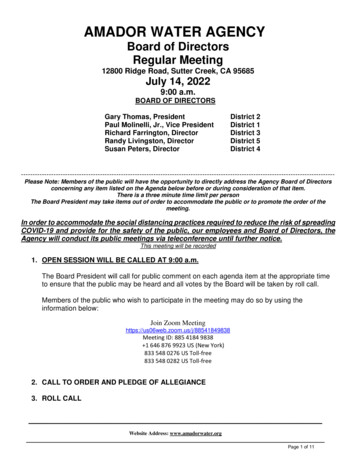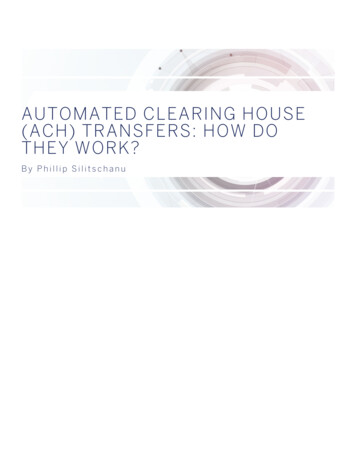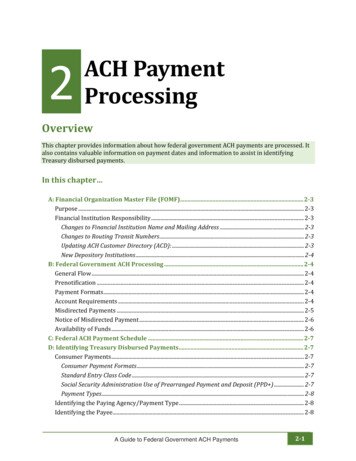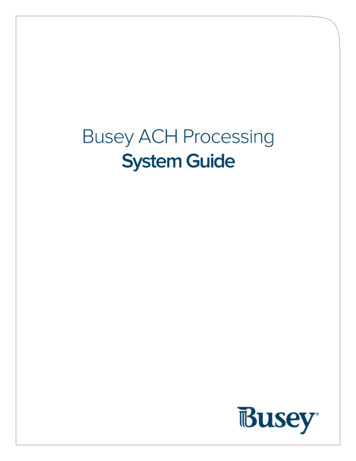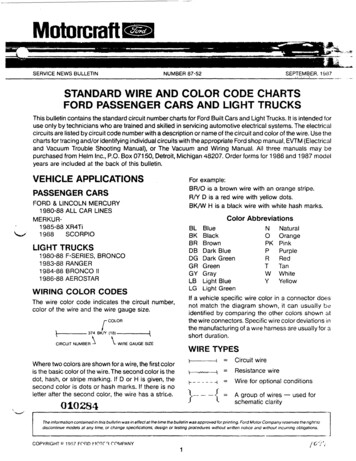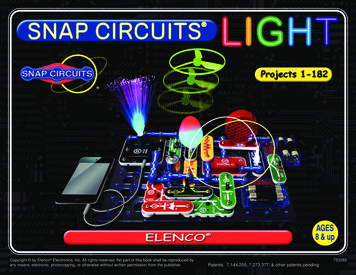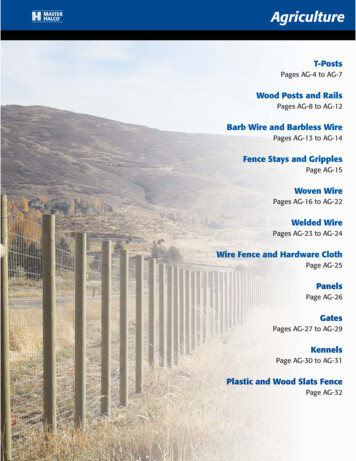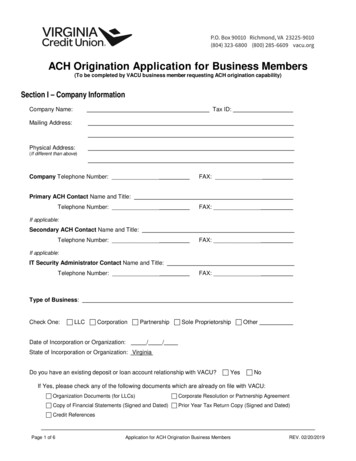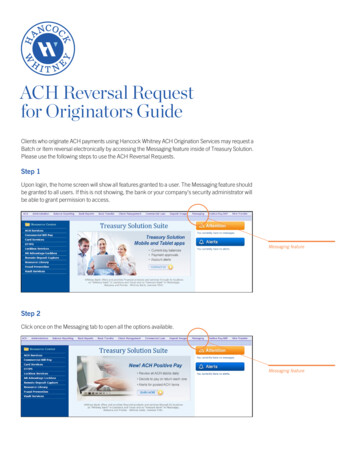
Transcription
ACH & WIREEDUCATION
VISIONBANKGREAT PEOPLE STRONG COMMUNITIES QUALITY SERVICE
Jean MallicoatVice President Commercial Deposit ServicesManagerjeanm@visionbank.comPh: (515) 433-4499 x 1017Brenda RomigVice President Operationsbrendar@visionbank.comPh: (515) 432-9493 x 10211-2. ACH PAYMENTS3-10. ACH PAYMENTS Q & A11-12. ACH GLOSSARY13-14. WIRE TRANSFERS Q & A
ACH PAYMENTS1WHAT IS THE ACH NETWORK?ACH (Automated Clearing House) refers to the nationwide, batch-orientedelectronic funds transfer system. The system moves large volumes oftransactions between participating financial institutions. ACH rules andregulations are established by the National Automated Clearing HouseAssociation (NACHA) and the Federal Reserve Bank’s ACH operatingcirculars.5 KEY ACH PARTICIPANTS12The Receiver is a person or organization that authorized the Originator(your company) to initiate an ACH entry to their account. For example,your employee is the Receiver if your company initiates a payroll credit.A business partner is the Receiver if your company is sending a creditor debit for goods or services.Your company is the Originator who initiates an ACH entry in responseto an authorization from a Receiver (consumer or organization) toeither credit or debit their account. For example, your company couldinitiate credit entries via the ACH network to pay your employeesor you could initiate debit entries to a consumer or business for thepayment of goods and services.3The Originating Depository Financial Institution (ODFI) is the financialinstitution that your company has a contract with for ACH servicesand is responsible for sending ACH entries into the ACH Network onyour behalf. The ODFI forwards ACH entries to the ACH Operator forprocessing.4The ACH Operator is the central clearing facility for ACH transactions.This can be the Federal Reserve Bank or private operator who acceptsACH entries from ODFIs and then forwards them to the Receiver’sfinancial institution.5The Receiving Depository Financial Institution (RDFI) is a financialinstitution that receives entries from its ACH Operator and posts themto the accounts of their customers (Receivers).
ACH PAYMENTS2ACH PROCESS- HOW IT WORKS1. Your company must enter into a written contract with your bank (ODFI)that allows you to initiate ACH entries.2. Your company must obtain authorization from the Receiver (youremployee or customer) to initiate a transaction to the Receiver’s account.3. Your company creates a file of ACH transactions and VisionBank will assignyou a company name that the Receiver will easily recognize.4. You will send the ACH file to your ODFI in the format required by the ODFI.Your ODFI collects ACH files, verifies the validity of the files, and thentransmits the files to the ACH Operator. The ACH Operator verifies the file toensure proper formatting and then distributes the files to RDFIs. The RDFIreceives the files for its account holders. The RDFI posts entries to Receiver’saccounts based upon the settlement date and the account number.HOW IT WORKSRECEIVERORIGINATORSTEP 1Authorizes ACH Payments.STEP 5STEP 2Funds are debited orcredited to the reciever.Payment Details.RDFIACH OPERATORODFISTEP 4STEP 3ACH Entry.ACH Entry.
ACH PAYMENTS Q & A3WHAT ARE MY REQUIREMENTS AS AN ORIGINATOR?To complete payments, the organization requesting a payment(whether they want to send funds or receive funds) must obtain writtenauthorization and bank account information from the other party involved.For example, an employer needs the following details from employees toset up direct deposit: The name of the bank or credit union receiving funds The type of account at that bank (checking or savings) The bank’s ABA routing number The recipient’s account numberWith that information, payments can be created and routed to thecorrect account. Billers need those same details to make pre-authorizedwithdrawals from customer accounts.GOVERNING RULES AND AGREEMENTSYou are required to abide by multiple rules, regulations, and agreementsincluding, but not limited to, the following when submitting ACH files andtransactions. NACHA Operating Rules (www.nacha.org) Regulation E (for consumer entries) UCC4A (for corporate credits) VisionBank Deposit Account Agreement VisionBank ACH Agreement Bank/Corporate Agreements Customer Authorizations
ACH PAYMENTS Q & AORIGINATOR RESPONSIBILITIES Protect the banking information received. Send entries on the proper date according to your critical timingcalendar. Make necessary changes to payee account information within sixbanking days when notified by VisionBank. Cease subsequent entries when appropriate. Originators must comply with Office of Foreign Assets Control (OFAC)sanctions. Anyone listed on an OFAC sanctions list is ineligible to send orreceive electronic funds (ACH or wires). Ensure you and your computer are protected by following theguidelines listed in the Cash Management and ACH OriginationAgreement.RECOMMENDATIONS FOR DIRECT DEPOSITNeither ACH Rules, nor Regulation E, require an authorization for ACHcredits or reversals. VisionBank recommends you use direct deposit authorization forms that allow the company to debit the employee’s account foradjustments. The forms may also be used to collect the proper employeeaccount information. As the originator, it is essential for you to verify thatthe routing number of an ACH participant is valid.WHAT ARE THE MOST COMMON ACH RETURN CODES?There is a long list of reasons why an ACH payment can be markedas returned. Some of the most common reasons are administrative;associated with an account that can’t be located or has been closed.4
ACH PAYMENTS Q & A5WHAT IS OUT OF BAND AUTHENTICATION ANDWHY IS IT IMPORTANT?Out-of-band authentication (OOBA) verifies your identity by usingverification of a user’s identity through the use of a mobile device, knownas phone authentication, and PIN number. OOBA provides added securitybecause even if a fraudulent user gains access to all security credentials toyour online banking account, a transaction cannot be completed withoutphone authentication.CATO ATTACKS, SHOULD I RELY ON AN EMAILREQUEST TO SEND AN ACH?Corporate Account Take Overs (CATO) occur when cyber thieves gaincontrol of systems by stealing sensitive employee credentials andinformation. If you receive an email request to send an ACH payment itis best practice to follow-up with the sender for additional security andverification.BEST PRACTICE RECOMMENDATIONS FOR BUSINESSES: Review risky behavior with employees, especially when openingunsolicited emails. Educate employees on what suspicious websites and maliciouscomputer optimization software looks like. Minimize the number of machines used for various business functions.Consider conducting online banking on dedicated machinessegregated from other business functions. Always lock computers when unattended. Especially those withadministrator access. When conducting ACH or Wire transfer activities, use dual controlsthrough two separate computers.
ACH PAYMENTS Q & AEXPOSURE LIMITSWhen your company enters into an agreement with your bank (ODFI),your bank will establish exposure limits. An exposure limit is themaximum dollar threshold for debits/credits your bank (ODFI) will acceptfrom your company – either for a single day or a multi-day period. Filessubmitted by your company that exceed this limit may be rejected unlessan exception is approved by the ODFI. For a typical payroll file, your bank(ODFI) will forward your ACH payroll file to the ACH Operator one dayprior to the settlement date. The ODFI will debit the account from whichthe ACH credit file will settle on the settlement date. If the Originatordoes not have sufficient funds on deposit to fund the ACH file on thesettlement date, an overdraft will occur. Therefore, the ODFI will establishan exposure limit as a method of managing the ODFI’s risk.On the debit side, the ODFI’s exposure begins on the date funds are madeavailable to the Originator and ends on the date on which debits can nolonger be returned by the RDFIs. Most entries must be returned withintwo banking days but the RDFI has up to 60 calendar days to returnunauthorized transactions. The amount of risk is based on the amount ofreturned ACH debit entries and the Originator’s ability to cover them.Ultimately, exposure limits are the maximum total established by theODFI beyond which the ODFI is unwilling to process additional ACHfiles. NACHA rules require ODFIs to set and monitor these limits. Yourbank (ODFI) will determine your exposure limit based on several factorsincluding transaction history, financial strength, and dollar amounts inprevious files processed.Some ODFIs will require you (the Originator) to pre-fund the amount ofan ACH credit file. This means the ODFI will debit or place a hold on your(the Originator) account on the date on which the file is sent to the ACHOperator to ensure funds are available to cover the file on the settlementdate.6
ACH PAYMENTS Q & A7WHAT IS AN ACH RETURN?An ACH return is an entry that the RDFI is unable to post for a reasondefined by NACHA (see common return reason codes below). The RDFImust initiate the return in time for your ODFI to receive it by opening ofbusiness on the second banking day following the settlement date of theoriginal entry. This is often referred to as the “24-hour return deadline.” TheRDFI may return some entries beyond this deadline; however, your ODFImust inform you of all returns promptly. The return will include a code thatdescribes the reason for the return.RETURNREASON CODEDESCRIPTIONORIGINATOR ACTIONR01Insufficient FundsOriginator may initiate a new ACH entrywithin 180 days of original settlement date(max of two additional attempts)R02Account ClosedOriginator must stop initiation of entries.Must obtain a new authorization fromReceiver for a different account.R03No Account/Unableto LocateOriginator must stop initiation of entriesand contact Receiver for correct accountinformation.R04Invalid AccountNumber StructureOriginator must stop initiation of entriesand contact Receiver for correct accountinformation.R05UnauthorizedDebit to ConsumerAccount UsingCorporate SEC CodeOriginator must stop initiation of entries.R06Returned per ODFI’sRequestODFI has requested RDFI to return anentry (optional to RDFI). Originator shouldcontact the ODFI should they need torequest an RDFI to return an entry.
ACH PAYMENTS Q & ARETURNREASON CODE8DESCRIPTIONORIGINATOR ACTIONR07AuthorizationRevoked byCustomerOriginator must stop initiation of entries.Must obtain a new authorization to initiateentries.R08Payment StoppedOriginator must contact Receiver to identifyreason for stop payment. Stop payment canbe for one or more debit entries. May neednew authorization to initiate entries.R09Uncollected FundsOriginator may initiate a new ACH entrywithin 180 days of original settlement date(max of two additional attempts)R10Customer AdvisesUnauthorized,Improper,Ineligible, or Partof an IncompleteTransactionOriginator must stop initiation of entries.Must obtain a new authorization to initiateentries.R16Account Frozen/Entry Returned PerOFAC InstructionOriginator must stop initiation of entries.R20Non TransactionAccountOriginator must stop initiation of entries.R23Credit Entry Refusedby ReceiverOriginator must obtain a new authorizationto initiate entries.R24Duplicate EntryOriginator should accept return.R29Corporate CustomerAdvises NotAuthorizedOriginator must stop initiation of entries.Must obtain a new authorization to initiateentries.
ACH PAYMENTS Q & A9WHAT ARE THE STANDARD ENTRY CLASS (SEC) CODES?SEC codes are payment types used by Originators to identify ACH debits orcredits. Commonly used SEC codes are as follows:SEC CODEDESCRIPTIONAPPLICATION USEAUTHORIZATIONREQUIREMENTSPPDPrearrangedPayment orDepositThis code is usedfor a credit or debitentry originated byan organization to aconsumer’s account. It canbe a single or recurringentry. PPD transactionsare widely used for directdeposit of payroll anddirect payments. Directpayments provides theability to collect fundsfrom a consumer’saccount. PPD can also beused for a return entry fee.If a company collects afee for a debit entry (ACHor check) that is returnedNSF or uncollected funds,the company can use PPDas long as proper notice isprovided.For PPD debits, theauthorization must bein writing, be readilyidentifiable as anACH authorization,have clear and readilyunderstandable terms,provide that theReceiver may revokethe authorization bynotifying the Originatorin the manner specifiedin the authorization,and be either signed orsimilarly authenticatedby the consumer. IowaLaw requires writtenauthorization for PPDpayroll deposits. Forother credit entries, theauthorization may bein writing or it may beobtained orally or by othernon-written means.CCDCorporateCredit or DebitProvides a way forcompanies to receive orsend ACH payments fromor to other companies.Companies that need totransmit remittance datawith the CCD entry (suchas invoice or purchaseorder number) may addan addenda record tocarry the payment relatedinformation.The Rules do notrequire the CCD/CTXauthorization to be aspecific form. The Rulesrequire the Originatorand Receiver to have anagreement that bindsthe Receiver to the Rules.This agreement shouldcontain the authorizationrequirements andprocedures as determinedby the parties.
ACH PAYMENTS Q & A10WHAT IS A NOTIFICATION OF CHANGE (NOC),WHAT ARE MY RESPONSIBILITIES?An NOC is a non-monetary entry transmitted by an RDFI to identifyincorrect information contained within an entry and also provides correctinformation to be used on future entries. NOC’s provide a means for anRDFI to post an entry to the Receiver’s account but also notifies yourcompany of changes that must be made. When an RDFI transmits anNOC, they warrant the information contained within the NOC is correct.Upon receipt of an NOC, the ODFI must notify you of the information thatmust be changed within 2 banking days. You must make the requestedchange(s) within 6 banking days or prior to initiation of another ACH entry,whichever is later. Some common NOC codes are below:CHANGE CODEDESCRIPTIONC01Incorrect Account Number or is formatted incorrectlyC02Incorrect Routing Number due to merger or consolidationC05Incorrect Transaction Code - The account number contained in theentry is a checking account but the transaction code is for a savingsaccount or vice versa.C06Incorrect Account Number and Transaction Code
ACH GLOSSARY11CORPORATE ACCOUNT TAKEOVER (CATO)CATO is a type of business identity theft in which a criminal gains accessto a business’ finances to make unauthorized transactions, includingtransferring funds, creating and adding new fake employees to a payrollfile and stealing customer information. Cyber thieves target employeesthrough phishing (fraudulent attempt to obtain confidential informationsuch as usernames and passwords for malicious reasons), phone calls,e-mails, and sometimes through social networks.NACHA released an ACH Bulletin on December 2, 2009, that summarizesCATO and what businesses can do to prevent it. vers-can-lead-fraudulent-transactions.As noted within the Bulletin, the top things a business can do is toimplement procedures such as dual control to initiate ACH payments,ensure anti-virus security software for all computers and laptops are upto-date, restrict functions for computers and laptops (such as general WEBbrowsing, social networking, etc.), monitor and reconcile accounts dailyand utilize alerts to detect unusual activity.INFORMATION SECURITYNACHA Rules establish data security requirements for all ACH transactionstransmitted or exchanged via an Unsecured Electronic Network (UEN).An example of a UEN is the Internet. Banking information, which includesrouting numbers, account numbers, etc. must be (1) encrypted, or (2)transmitted via a secure session using commercially reasonable securitytechnology. The concept of “commercially reasonable” means that aparty, given the facts of a specific transaction, acted in a way that areasonable person in similar circumstances would have acted. Ultimately,the Originator must implement procedures to protect the security andintegrity of ACH data throughout its life-cycle.The Originator must establish, implement, and update security policies,procedures, and systems related to the initiation, processing and storageof protected information (non-public personal information, includingfinancial information, of a natural person used to create, or containedwithin an entry and any related addenda record).
ACH GLOSSARY12RECORD RETENTIONThe Originator must retain the original of each written authorization ofthe Receiver, or a readily and accurately reproducible record evidencingany other form of authorization, for two years from the termination orrevocation of the authorization. The Originator must be able to providethe ODFI with an accurate copy or other accurate record to the RDFI withinten banking days without charge. NOW ONTO WIRES
WIRE TRANSFERS Q & A13WHAT ARE WIRE TRANSFERS?When you need to send or receive money fast, a wire transfer might be theright tool for the job. Wire transfers are quick, reliable, and safe (as long asyou’re not sending money to a thief ).A wire transfer is an electronic transfer of funds from one financialinstitution to another. To receive a wire transfer into your checking account,you will need to provide the sender of the wire transfer the appropriaterouting number and your checking account number.HOW IT WORKSSTEP 1SENDERGet correct informationfrom reciever or bank.RECEIVINGBANKSTEP 6Funds creditedto receiver.STEP 2Submits wire transfer form toinitiate transaction.STEP 5Receives funds.RECEIVERSTEP 3Funds withdrawn.STEP 4Transfers funds.LOCAL BANKFEDERAL RESERVE OROTHER PROCESSOR
WIRE TRANSFERS Q & A14BEST PRACTICES ON USING WIRE TRANSFERS It is important to remember that once a wire is gone, it is gone. Know who you are wiring funds to. Ensure the correct beneficiary information is listed.WHAT TO DO IF A WIRE I SENT IS FRAUDULENTCASH MANAGEMENT CUSTOMERSContact the VisionBank Cash Management Help Group immediately.PERSONAL CUSTOMERSContact your VisionBank Retail Banker immediately.VisionBank staff will work with you throughout the process, but we cannotguarantee recovery once the funds have been sent.WIRE TRANSFERSTRANSFER SPEEDCERTAINTY &SAFETYCOSTMove funds from one bank to another within onebusiness day.The phone verification process is VisionBank’s extralayer of protection against fraud and identity theft. Youwill be asked to verify the transaction by phone beforethe transfer can be completed.Fees and limits may apply, depending on youraccount type and the type of wire. You will be ableto review any fees and limits before completing yourwire transfer.
AMESBOONE515-956-4343104 Chestnut Street107 Main Street4510 Mortensen Road515-433-44991704 S Marshall Street504 Story StreetHUXLEYGRIMES515-597-4477100 Centennial Drive515-986-5746925 SE Gateway DriveOGDEN515-275-2420217 W Mulberry Streetwww.VisionBank.com800-574-8123
request an RDFI to return an entry. An ACH return is an entry that the RDFI is unable to post for a reason defined by NACHA (see common return reason codes below). The RDFI must initiate the return in time for your ODFI to receive it by opening of business on the second banking day following the settlement date of the original entry.
